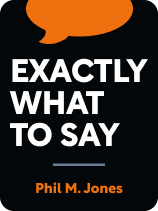

This article is an excerpt from the Shortform book guide to "Exactly What to Say" by Phil M. Jones. Shortform has the world's best summaries and analyses of books you should be reading.
Like this article? Sign up for a free trial here.
Looking for some sales persuasion techniques? What are the best techniques for convincing a customer to buy something?
Author Phil M. Jones has written seven best-selling business books and emphasizes the quality of conversations as the key to persuading customers. In Exactly What to Say, he shares his best sales persuasion techniques and key phrases that appeal to the customer’s subconscious mind.
Read on for Jones’s best sales persuasion techniques, according to the advice in Exactly What to Say.
Jones’s Sales Persuasion Techniques
Phil M. Jones has been a professional salesman since he was a teenager, in industries ranging from professional soccer to real estate. He does motivational speaking events and trainings around the world to help business professionals improve their communication skills. He has written seven best-selling business books and emphasizes the quality of conversations as the key to persuading customers. In this article, we’ll explain Jones’s sales persuasion techniques based on his book, Exactly What to Say, which focuses on the strategy of subconscious persuasion and key phrases that convince the customer to say yes.
What Is Subconscious Persuasion?
The common thread in Jones’s advice for landing a sale is that all the key phrases target a subconscious tendency in the listener. Jones emphasizes that the phrases are meant to trigger a reflexive response, without the listener actively analyzing and thinking about what you’ve said. Using this tactic gets people to agree with you faster and avoids time they might otherwise spend being indecisive and critical. For example, when you tell someone, “Just imagine how happy you’ll be when you add this item to your collection,” the person automatically envisions this scenario and feels the emotion associated with it rather than focusing on a logical assessment of the purchase.
| Strategies for Appealing to the Customer’s Subconscious Research suggests that the subconscious brain is responsible for 95% of our decision-making when it comes to purchases, validating Jones’s emphasis on subconscious persuasion. Rather than using specific phrases to trigger subconscious responses, other business books emphasize presentation qualities that appeal to prospective customers’ subconscious. For example, in The Psychology of Selling, Brian Tracy recommends presentation strategies for subconscious persuasion such as keeping your office organized, conveying enthusiasm, asking expert questions, displaying open body language, and controlling the conversation. Similarly, Jordan Belfort’s Way of the Wolf recommends appealing to subconscious biases by using your tone to connect emotionally (for example, an intense, lowered voice stimulates a sense of urgency in the customer), dressing professionally, making eye contact, and adjusting your physical stance depending on the circumstances. For example, when selling to a person of the opposite sex, stand directly opposite the customer, and when selling to a person of the same sex, stand or sit at an angle to the customer. |
#1: Identify Your Customer Type Early
To make the most of Jones’s sales persuasion techniques, we’ll explain why it’s important to first identify your customer type. In The Psychology of Selling, Tracy argues that before you begin using persuasion techniques, getting a sense of your audience early in the conversation helps you tailor your responses to the customer’s personality and needs. Here are his six common types of customers and how to best interact with them:
- The Reluctant Customer is cynical and uninterested. Spend minimal time with them.
- The Certain Customer has a clear idea of what they want and how much they’re willing to pay. Don’t try to oversell them.
- The Analytical Customer likes to move slowly to ensure they’re making the right decision. Focus on details and give them thorough information.
- The Relationship Customer likes to establish a rapport before making a purchase. Take an interest in them and ask lots of questions.
- The Directive Customer is busy and practical. Get to the main point quickly and tell them exactly how you can benefit them.
- The Social Customer is talkative and friendly. Be cheerful and open with them, and get agreements with them in writing, so they don’t forget their commitment.
#2: Predict & Avoid Customer Objections
According to Jones, one way to land a sale using a persuasion technique at the beginning of a conversation is to use the phrase “I bet you’re a bit like me…” to get people to agree to a baseline assumption and set the stage for them to accept your offer.
For example, you could say “I bet you’re a bit like me, and you like to minimize the time you spend on administrative work, so you can do more interesting things.” Jones suggests that when you use this phrase on a stranger, they are likely to simply agree because it’s the easiest course of action. If they respond positively, they’ve already agreed to something that should logically make them want to buy your product, so it’s harder for them to refuse your pitch.
Without this phrase, it’s easy for the other person to say, “I’m not interested in that,” in response to your offer, which is difficult for you to refute.
| Common Ground as a Persuasion Technique In Thinking in Bets, Annie Duke describes a related strategy to persuade other people (not necessarily in a business context). However, rather than getting someone to agree with a statement because it’s the easiest way forward, as Jones implies, Duke recommends finding something that you genuinely have in common with the other person. This acts as a segue to convince the other person of something they disagreed with before. For example, “We both agree that education is important, and my product is designed to help students learn better.” The statement starts by establishing a shared value, making it harder for the other person to shut down the conversation. This strategy is more applicable when making a sale to someone you have some information about, rather than a random stranger. |
#3: Use Emotional Appeal
Because people are emotionally driven, another persuasion technique in sales is to leverage the customer’s natural desire to feel positive emotions and avoid negative emotions. Jones argues that when you use the phrase “How would you feel if…” you make people actually experience the emotion of the conditional scenario.
For example, you can say, “How would you feel if you bought this product, and it helped you surpass your sales goal within six months?” This language makes the customer feel a positive emotion in the context of your product and makes them believe that the described outcome is possible, motivating them to accept your offer to manifest that feeling in the future.
On the flip side, Jones explains that appealing to a desire to avoid negative emotions motivates buyers as well. For example, “How would you feel if you passed up this opportunity and then later realized it would have helped you significantly?” The question motivates customers to purchase the product to avoid the scenario you’ve described and the negative emotions that come with it.
Another sales technique to persuade the customer using emotion is with the phrase “The good news is…”. This phrase subconsciously stimulates positive emotions and makes people want to act on them by accepting your offer. For example, you could say, “The good news is, I can give you a special deal on my product for this one time only.” The key phrase signals to the listener that something positive is happening, whether or not they were initially wanting that product. The positive feeling they experienced makes them want to capitalize on the good news by accepting your offer.
#4: Give Polarizing Options
Listing polarizing options is another sales persuasion technique to use with an undecided customer because it creates the illusion that they have to make a decision between the limited options you’ve given them. Jones claims that when one of the options is clearly framed as the best scenario, it makes it easier for the person to quickly choose your desired response.
One example of how to use this persuasion technique in sales is to say, “There are two types of people, those who let big opportunities slip by because they’re afraid to take risks, and those who seize opportunities that will help them achieve their vision.” People generally like the idea of achieving success, and they don’t like the idea of being fearful and missing out on opportunities. Therefore, even if there are actually infinite types of people and potential outcomes, the customer is likely to accept your offer because they’re motivated to choose the only option you’ve given them with a positive outcome.
Instead of letting the person agonize over many possibilities, this tactic encourages their subconscious brain to choose your desired response without directly telling them what to do.
(Shortform note: In The Art of Thinking Clearly, Rolf Dobelli explains the perils of having too many options, validating Jones’s tactic of presenting only two options. According to Dobelli, having too many options to consider paralyzes you and fosters uncertainty. Both of these reactions are related to humans’ natural loss aversion (because the more options we have, the more we fear that we’ll miss out on something we don’t choose), as well as decision fatigue, which occurs when analyzing options drains you of your ability to make decisions. Based on this evidence, it’s beneficial to give a customer limited options for potential outcomes and limit the number of products for the customer to choose from.)

———End of Preview———
Like what you just read? Read the rest of the world's best book summary and analysis of Phil M. Jones's "Exactly What to Say" at Shortform.
Here's what you'll find in our full Exactly What to Say summary:
- How to improve your business interactions by using key phrases
- How to appeal to your listener’s subconscious mind and guide them to a decisive “yes”
- How you can capitalize on a conversation even if a customer says "no"






